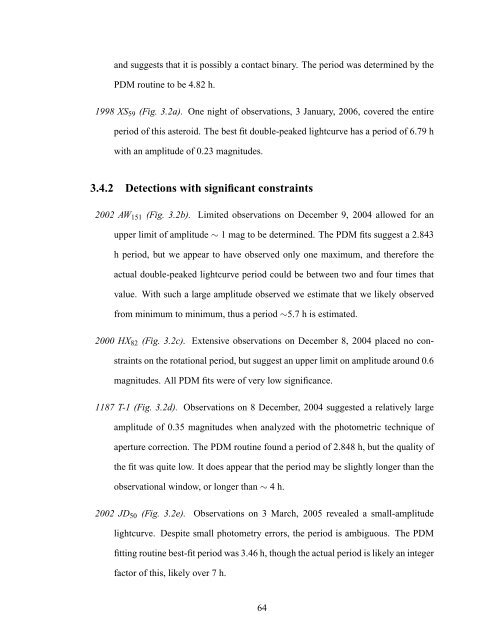Forming Binary Near-Earth Asteroids From Tidal Disruptions
Forming Binary Near-Earth Asteroids From Tidal Disruptions
Forming Binary Near-Earth Asteroids From Tidal Disruptions
Create successful ePaper yourself
Turn your PDF publications into a flip-book with our unique Google optimized e-Paper software.
and suggests that it is possibly a contact binary. The period was determined by thePDM routine to be 4.82 h.1998 XS 59 (Fig. 3.2a). One night of observations, 3 January, 2006, covered the entireperiod of this asteroid. The best fit double-peaked lightcurve has a period of 6.79 hwith an amplitude of 0.23 magnitudes.3.4.2 Detections with significant constraints2002 AW 151 (Fig. 3.2b). Limited observations on December 9, 2004 allowed for anupper limit of amplitude ∼ 1 mag to be determined. The PDM fits suggest a 2.843h period, but we appear to have observed only one maximum, and therefore theactual double-peaked lightcurve period could be between two and four times thatvalue. With such a large amplitude observed we estimate that we likely observedfrom minimum to minimum, thus a period ∼5.7 h is estimated.2000 HX 82 (Fig. 3.2c). Extensive observations on December 8, 2004 placed no constraintson the rotational period, but suggest an upper limit on amplitude around 0.6magnitudes. All PDM fits were of very low significance.1187 T-1 (Fig. 3.2d). Observations on 8 December, 2004 suggested a relatively largeamplitude of 0.35 magnitudes when analyzed with the photometric technique ofaperture correction. The PDM routine found a period of 2.848 h, but the quality ofthe fit was quite low. It does appear that the period may be slightly longer than theobservational window, or longer than ∼ 4 h.2002 JD 50 (Fig. 3.2e). Observations on 3 March, 2005 revealed a small-amplitudelightcurve. Despite small photometry errors, the period is ambiguous. The PDMfitting routine best-fit period was 3.46 h, though the actual period is likely an integerfactor of this, likely over 7 h.64












